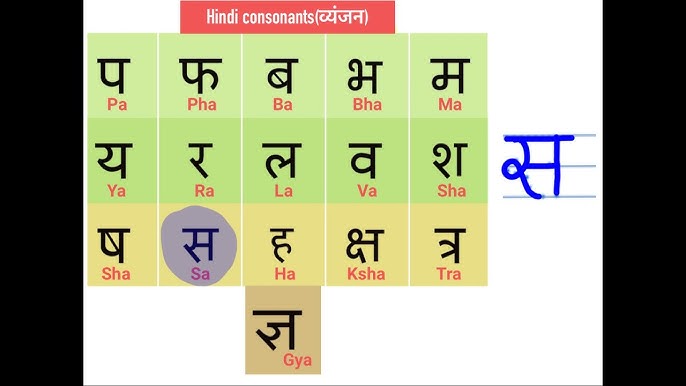Hindi consonants, known as “व्यंजन” (Vyanjan), form an essential part of the Hindi language. There are 33 primary consonants in the Hindi script, each representing distinct sounds. These consonants are written in the Devanagari script and range from simple sounds like “क” (ka) to complex ones like “क्ष” (ksha). Learning Hindi consonants is key to mastering pronunciation and reading skills in Hindi. They are categorized based on the place of articulation, such as guttural, dental, and labial sounds. Understanding Hindi consonants lays the foundation for building vocabulary and improving communication in the language.
Introduction to Hindi Consonants: Examples and Usage
Hindi is written in Devanagari script, which consists of 36 consonants and 12 vowels. Some of the commonly used Hindi consonants include क (ka), ग (ga), च (cha), and ध (dha). These consonants form the basis of words in the Hindi language, with vowels added to create complete sounds.
For example, the word कलम (kalam) means pen in Hindi. Here, the consonants क (ka) and ल (la) are combined with the vowel अ (a) to form the word. Similarly, the word गर्मी (garmi) means heat, where the consonants ग (ga), र (ra), and म (ma) are used along with the vowels अ (a) and इ (i) to form the word.
By learning these consonants and how they combine with vowels, one can start forming basic words and gradually build a strong foundation in the language.
Comparison of Consonants in Hindi and English
Hindi and English both have a similar set of consonant sounds, with some differences in the number and pronunciation of certain sounds. In Hindi, there are 33 consonant sounds, while in English there are 24 consonant sounds. The Hindi language includes sounds like retroflexes and aspirates, which are not present in English. For example, the retroflex sounds ‘ṭ’ and ‘ḍ’ are unique to Hindi and require a different tongue placement compared to English sounds.
Another difference between Hindi and English consonants is the varied use of palatal sounds in Hindi. Palatal sounds like ‘ch’ and ‘j’ are common in Hindi but less frequently used in English. The pronunciation of these sounds can be challenging for English speakers learning Hindi, as they involve a different mouth position and airflow. Additionally, Hindi has a distinction between voiced and voiceless aspirated consonants, while English typically does not make this distinction.
Despite these differences, there are also many similarities between Hindi and English consonants. Both languages have common consonant sounds like ‘p’, ‘t’, and ‘k’ that are produced similarly. Some sounds, such as ‘m’ and ‘n’, are phonetically the same in both languages. These similarities can help English speakers learn Hindi consonant sounds more easily and improve their pronunciation.
Common Consonant Words in Hindi: Pronunciation Tips
In Hindi, many common consonant words can be a bit tricky to pronounce for non-native speakers. One key tip is to pay attention to the placement of the tongue and the way air is expelled when pronouncing certain sounds. For example, the aspirated “oh” sound is produced when the tongue is placed at the back of the mouth and a burst of air is released as you say the sound. Practicing these sounds with a native speaker or language partner can be very helpful in improving your pronunciation.
Another important tip is to remember that in Hindi, certain consonant sounds can change based on the placement of vowels in a word. For example, the consonant “k” can sound different when paired with different vowels. It’s important to listen closely to native speakers and pay attention to how they pronounce these sounds in different contexts. This will not only help you improve your pronunciation but also your overall understanding of the language.
Lastly, practicing regularly and being patient with yourself is key to mastering the pronunciation of common consonant words in Hindi. Don’t be afraid to make mistakes and keep practicing until you feel more comfortable with the sounds. Remember that language learning is a journey, and with time and dedication, you will see improvements in your pronunciation skills.
Exploring Hindi Consonants and Vowels: Important Differences
You pronounce it with a unique flow of air that distinguishes them from vowels. Hindi classifies consonants based on where you produce the sound in the mouth or throat. For example, you produce guttural consonants like क (ka) and ख (kha) in the throat, while you use the palate to produce palatal consonants like च (cha) and छ (chha). These distinctions make the pronunciation of Hindi consonants key to mastering the language.
On the other hand, Hindi vowels are open sounds that are produced with minimal obstruction in the mouth or throat. Vowels in Hindi are classified as short or long and have specific symbols to represent them in writing. The pronunciation of Hindi vowels is crucial for understanding and communicating effectively in the language. Vowels like आ (aa) and ई (ee) have distinct sounds that differentiate them from consonants, making their pronunciation important in Hindi communication.
Understanding the differences between Hindi consonants and vowels is essential for proper pronunciation and comprehension of the language. Consonants and vowels play a significant role in forming words and conveying meaning in spoken and written Hindi. By mastering the pronunciation of Hindi consonants and vowels, learners can enhance their proficiency in the language and effectively engage with native speakers.
Understanding Comparison to Tamil: A Linguistic Analysis
Hindi and Tamil are two languages that belong to different language families, with Hindi being an Indo-European language and Tamil being a Dravidian language. When comparing the consonant systems of both languages, it is important to note that Hindi has a larger inventory of consonants compared to Tamil. Hindi has 33 consonants, while Tamil has 18 consonants.
In terms of articulation, both Hindi and Tamil share some similarities in their consonant sounds. For example, both languages have stops, nasals, fricatives, and liquids in their consonant inventories. However, there are also some distinct differences between the two languages. For instance, Hindi has retroflex consonants, which are absent in Tamil. In contrast, Tamil features a unique alveolar lateral approximant sound that Hindi does not have.
Overall, the comparison of Hindi and Tamil consonants highlights the diversity and richness of the sounds present in each language. Understanding these differences can help language learners appreciate the unique phonetic qualities of both Hindi and Tamil, contributing to a deeper understanding of the linguistic diversity present in India.
A Tense Chart with Rules and Examples PDF is an essential tool for understanding English grammar. It outlines the various tenses used in the language, including past, present, and future forms. We explain each tense with rules and accompany them with examples, making it easier for learners to grasp when and how to use them. Whether you’re learning basic tenses or more complex ones like present perfect or past continuous, a well-organized chart simplifies the process. Downloading a Tense Chart with Rules and Examples PDF can help students revise and master tenses for both writing and speaking.






[…] Hindi consonants are vital components of the language, forming the backbone of words and sentences. In Hindi, there are 33 primary consonants, each with unique sounds and pronunciations. These consonants include क (ka), ख (kha), ग (ga), घ (gha), च (cha), छ (chha), and many others. Understanding Hindi consonants is crucial for mastering reading, writing, and pronunciation. Each consonant can combine with vowels to create various syllables, enriching the language’s expressiveness. By familiarizing yourself with these consonants, you can enhance your Hindi language skills and communicate more effectively. […]